FORD MUSTANG 1998 4.G Repair Manual
Manufacturer: FORD, Model Year: 1998, Model line: MUSTANG, Model: FORD MUSTANG 1998 4.GPages: 192, PDF Size: 1.67 MB
Page 61 of 192

Theft indicator
The theft indicator on the instrument cluster will
operate as follows:
²When the ignition is OFF, the theft indicator will
flash briefly every 2 seconds to indicate the
SecuriLockysystem is protecting your vehicle.
²
When the ignition is turned to RUN or START, the
theft indicator will light for 3 seconds and then go
out. If the theft indicator stays on for an extended
period of time or flashes rapidly, have the system
serviced by your dealership or a qualified technician.
Programming spare SecuriLockYkeys
Spare SecuriLockykeys can be purchased from
your dealership and programmed to your
SecuriLockypassive anti-theft system (up to a total
of 8 keys). Your dealership can program your new
SecuriLockykey(s) to your vehicle or you can do it
yourself using the following simple procedure. To
program a new SecuriLockykey yourself, you will
need two previously programmed SecuriLockykeys
(keys that already operate your vehicle's engine). If
two previously programmed SecuriLockykeys are
not available (one or both of your original keys were
lost or stolen), you must bring your vehicle to your
dealership to have the spare SecuriLockykey(s)
programmed.
Procedure to program spare SecuriLockYkeys
to your vehicle
New SecuriLockykeys must have the correct
mechanical key cut for your vehicle.
Conventional (non-SecuriLocky) keyscannotbe
programmed to your vehicle.
You will need to have two previously programmed
SecuriLockykeys and the new unprogrammed
SecuriLockykey readily accessible for the
procedure. Please read and understand the entire
procedure before you begin.
Controls and features
61
Page 62 of 192

1. Insert the first previously programmed
SecuriLockykey into the ignition and turn the
ignition from OFF to RUN (maintain ignition in RUN
for at least one second).
2. Turn ignition to OFF and remove the first
SecuriLockykey from the ignition.
3. Within five seconds of turning the ignition to OFF,
insert the second previously programmed
SecuriLockykey into the ignition and turn the
ignition from OFF to RUN (maintain ignition in RUN
for at least one second but no more than 5 seconds).
4. Turn the ignition to OFF and remove the second
SecuriLockykey from the ignition.
5. Within 10 seconds of turning the ignition to OFF,
insert the unprogrammed SecuriLockykey (new
key) into the ignition and turn the ignition from OFF
to RUN (maintain ignition in RUN for at least one
second). This step will program your new
SecuriLockykey.
6. To program additional SecuriLockykey(s), repeat
this procedure from step 1.
If the programming procedure was successful, the
new SecuriLockykey(s) will start the vehicle's
engine. The theft indicator (located on the
instrument cluster) will light for three seconds and
then go out.
If the programming procedure was not successful,
the new SecuriLockykey(s) will not operate the
vehicle's engine. The theft indicator will flash on and
off. Wait at least one minute and then repeat the
procedure from step 1. If failure repeats, bring your
vehicle to your dealership to have the spare
SecuriLockykey(s) programmed.
Controls and features
62
Page 63 of 192
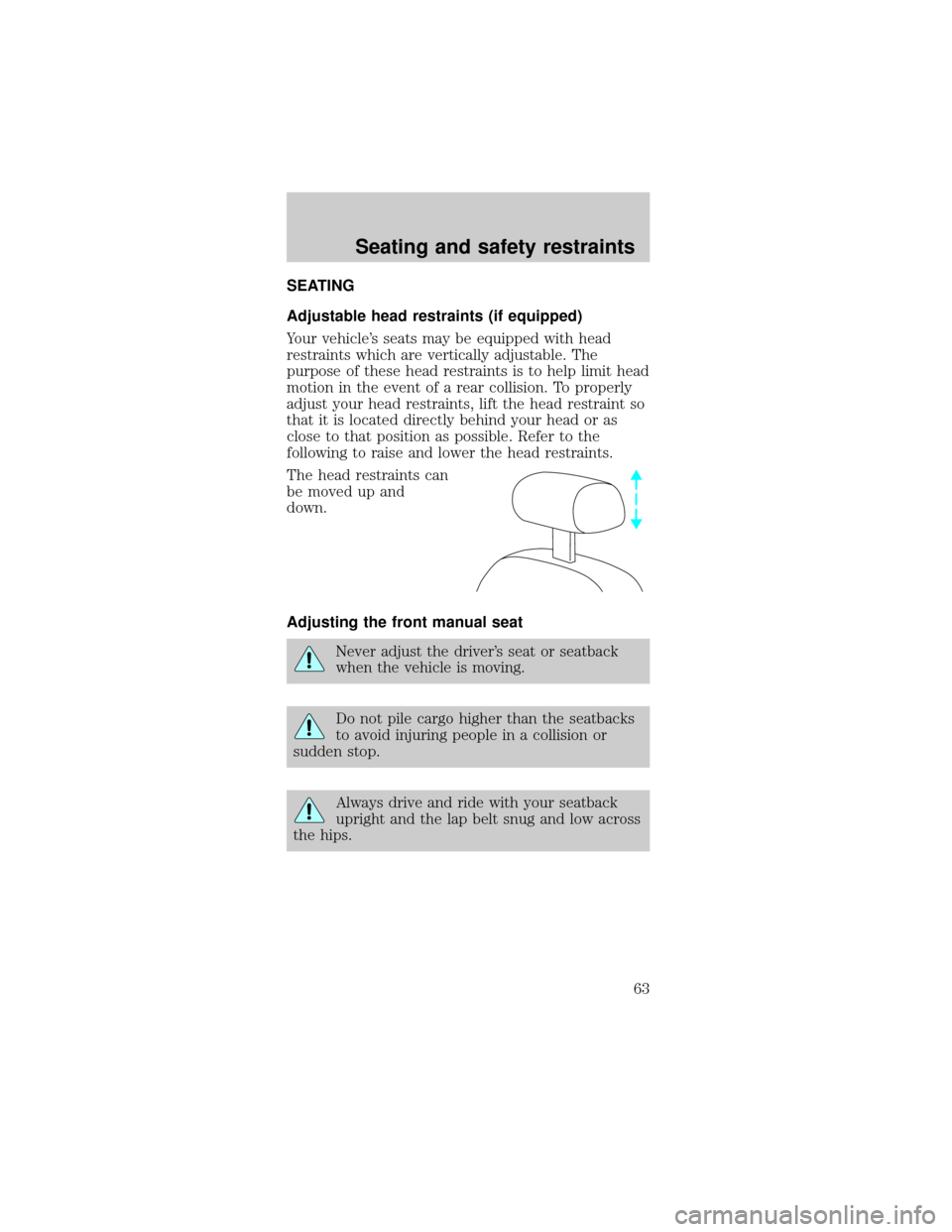
SEATING
Adjustable head restraints (if equipped)
Your vehicle's seats may be equipped with head
restraints which are vertically adjustable. The
purpose of these head restraints is to help limit head
motion in the event of a rear collision. To properly
adjust your head restraints, lift the head restraint so
that it is located directly behind your head or as
close to that position as possible. Refer to the
following to raise and lower the head restraints.
The head restraints can
be moved up and
down.
Adjusting the front manual seat
Never adjust the driver's seat or seatback
when the vehicle is moving.
Do not pile cargo higher than the seatbacks
to avoid injuring people in a collision or
sudden stop.
Always drive and ride with your seatback
upright and the lap belt snug and low across
the hips.
Seating and safety restraints
63
Page 64 of 192
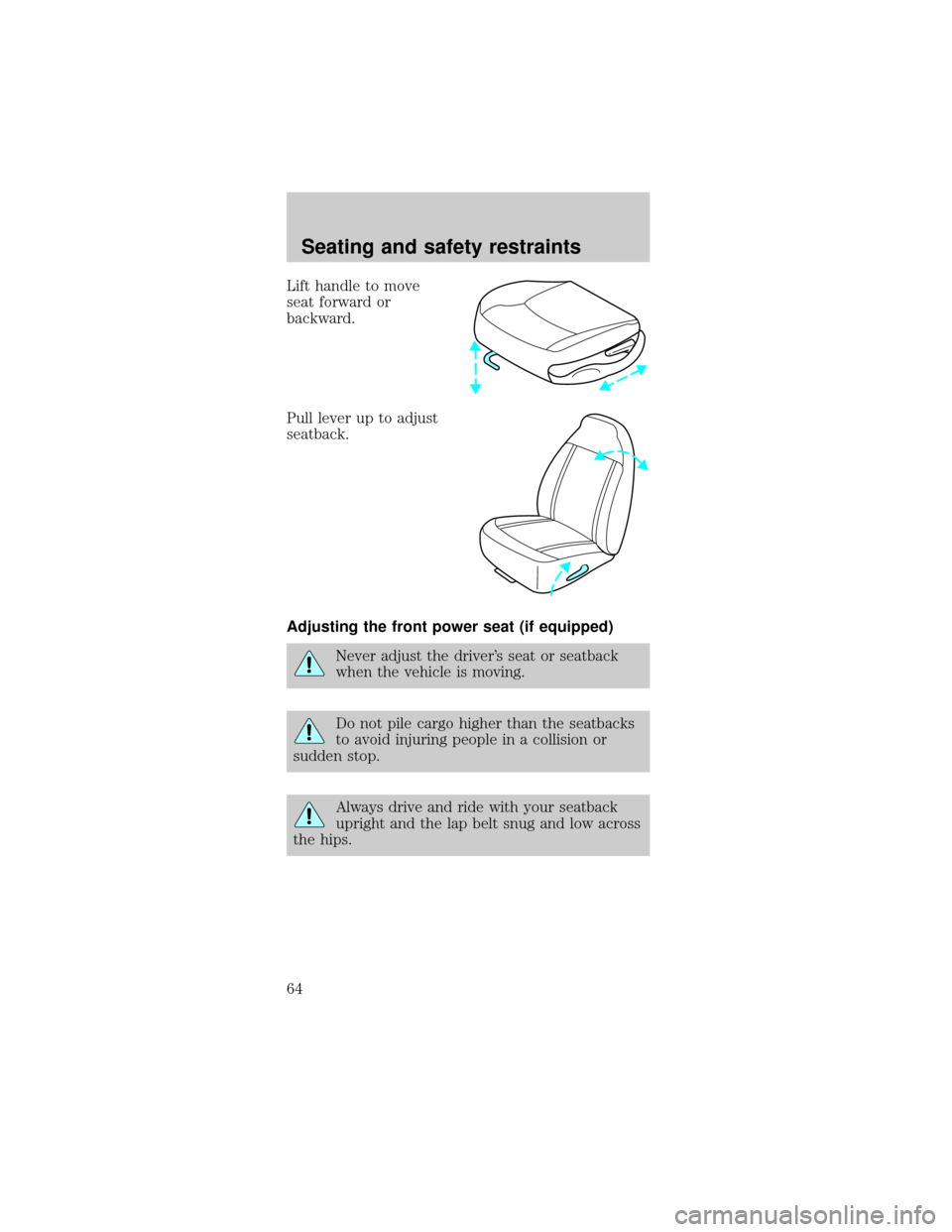
Lift handle to move
seat forward or
backward.
Pull lever up to adjust
seatback.
Adjusting the front power seat (if equipped)
Never adjust the driver's seat or seatback
when the vehicle is moving.
Do not pile cargo higher than the seatbacks
to avoid injuring people in a collision or
sudden stop.
Always drive and ride with your seatback
upright and the lap belt snug and low across
the hips.
Seating and safety restraints
64
Page 65 of 192
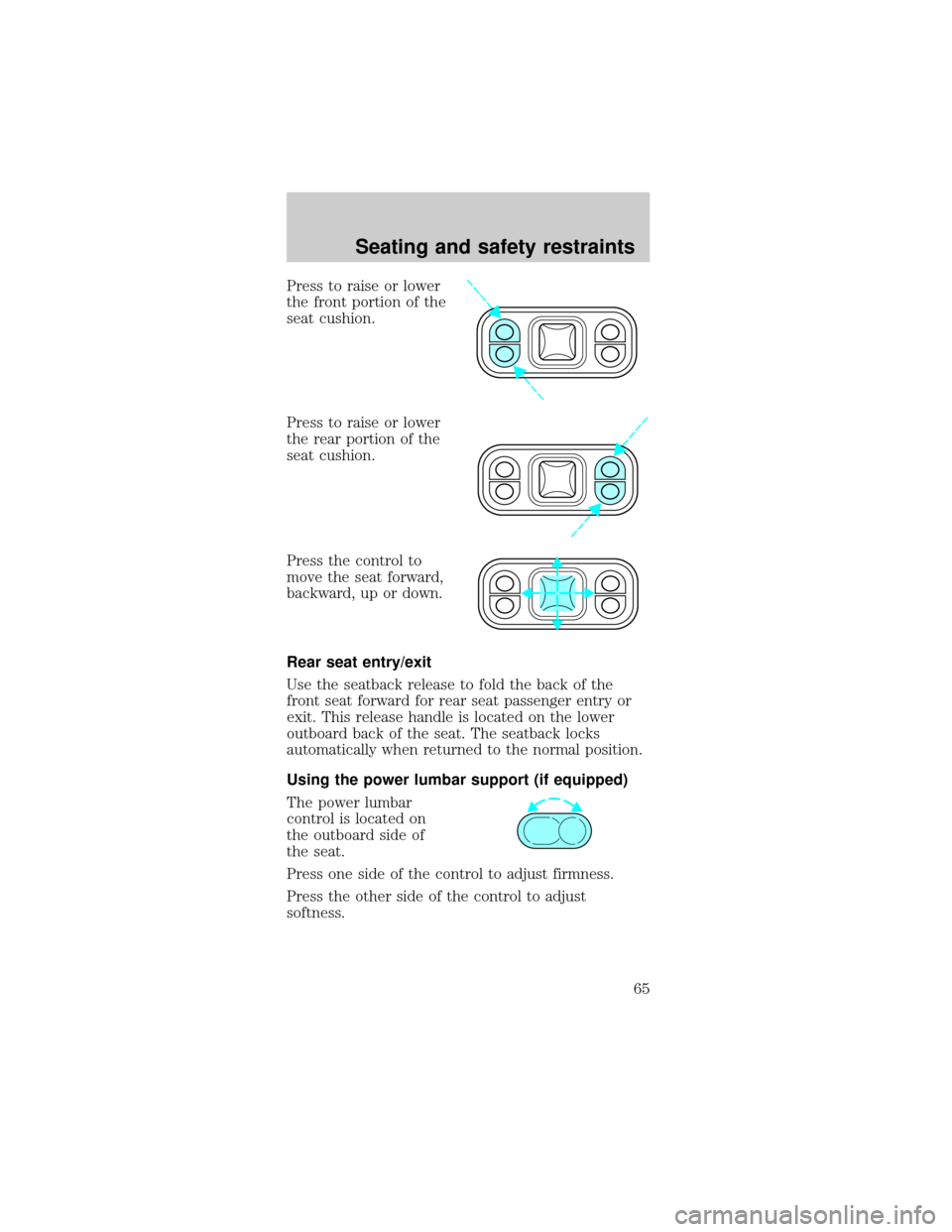
Press to raise or lower
the front portion of the
seat cushion.
Press to raise or lower
the rear portion of the
seat cushion.
Press the control to
move the seat forward,
backward, up or down.
Rear seat entry/exit
Use the seatback release to fold the back of the
front seat forward for rear seat passenger entry or
exit. This release handle is located on the lower
outboard back of the seat. The seatback locks
automatically when returned to the normal position.
Using the power lumbar support (if equipped)
The power lumbar
control is located on
the outboard side of
the seat.
Press one side of the control to adjust firmness.
Press the other side of the control to adjust
softness.
Seating and safety restraints
65
Page 66 of 192
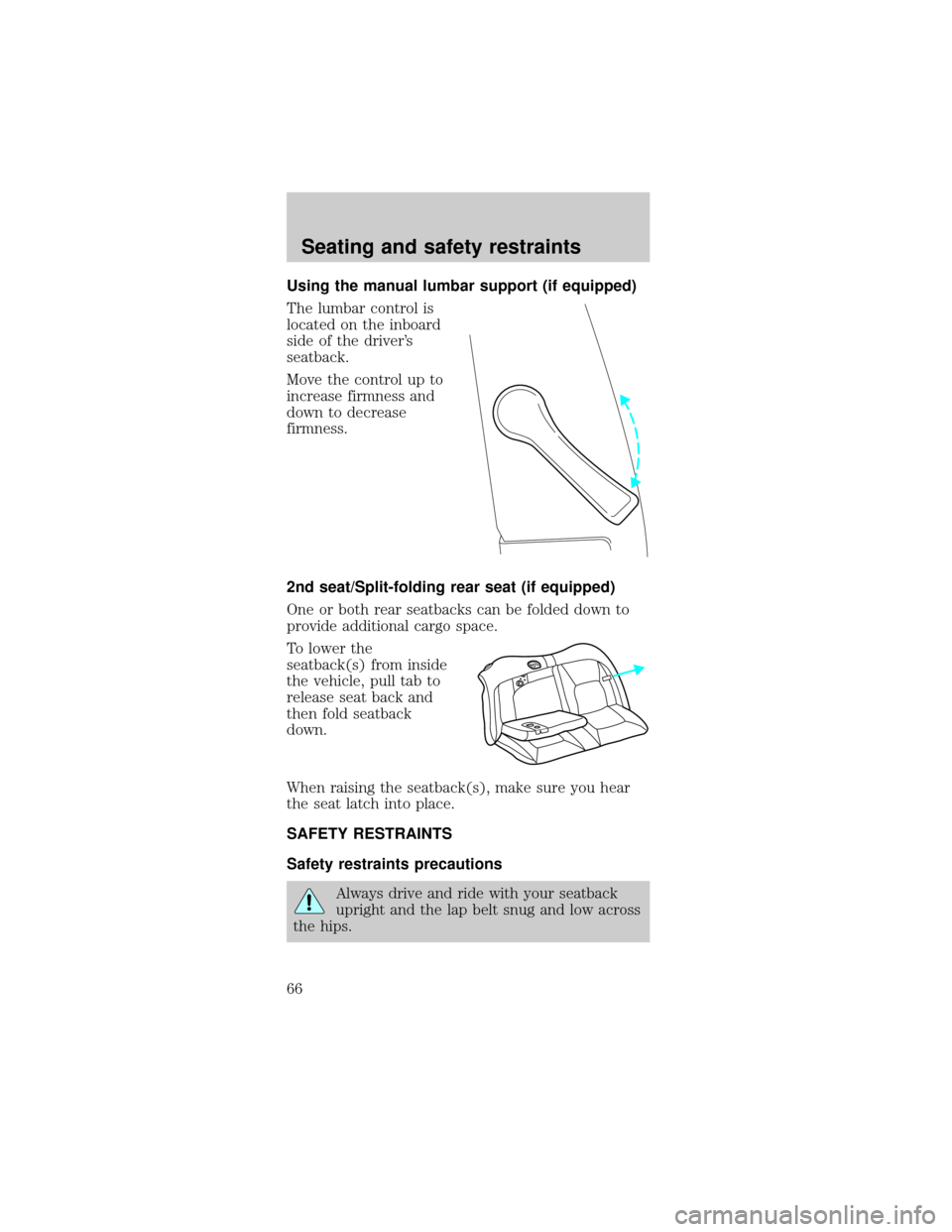
Using the manual lumbar support (if equipped)
The lumbar control is
located on the inboard
side of the driver's
seatback.
Move the control up to
increase firmness and
down to decrease
firmness.
2nd seat/Split-folding rear seat (if equipped)
One or both rear seatbacks can be folded down to
provide additional cargo space.
To lower the
seatback(s) from inside
the vehicle, pull tab to
release seat back and
then fold seatback
down.
When raising the seatback(s), make sure you hear
the seat latch into place.
SAFETY RESTRAINTS
Safety restraints precautions
Always drive and ride with your seatback
upright and the lap belt snug and low across
the hips.
Seating and safety restraints
66
Page 67 of 192
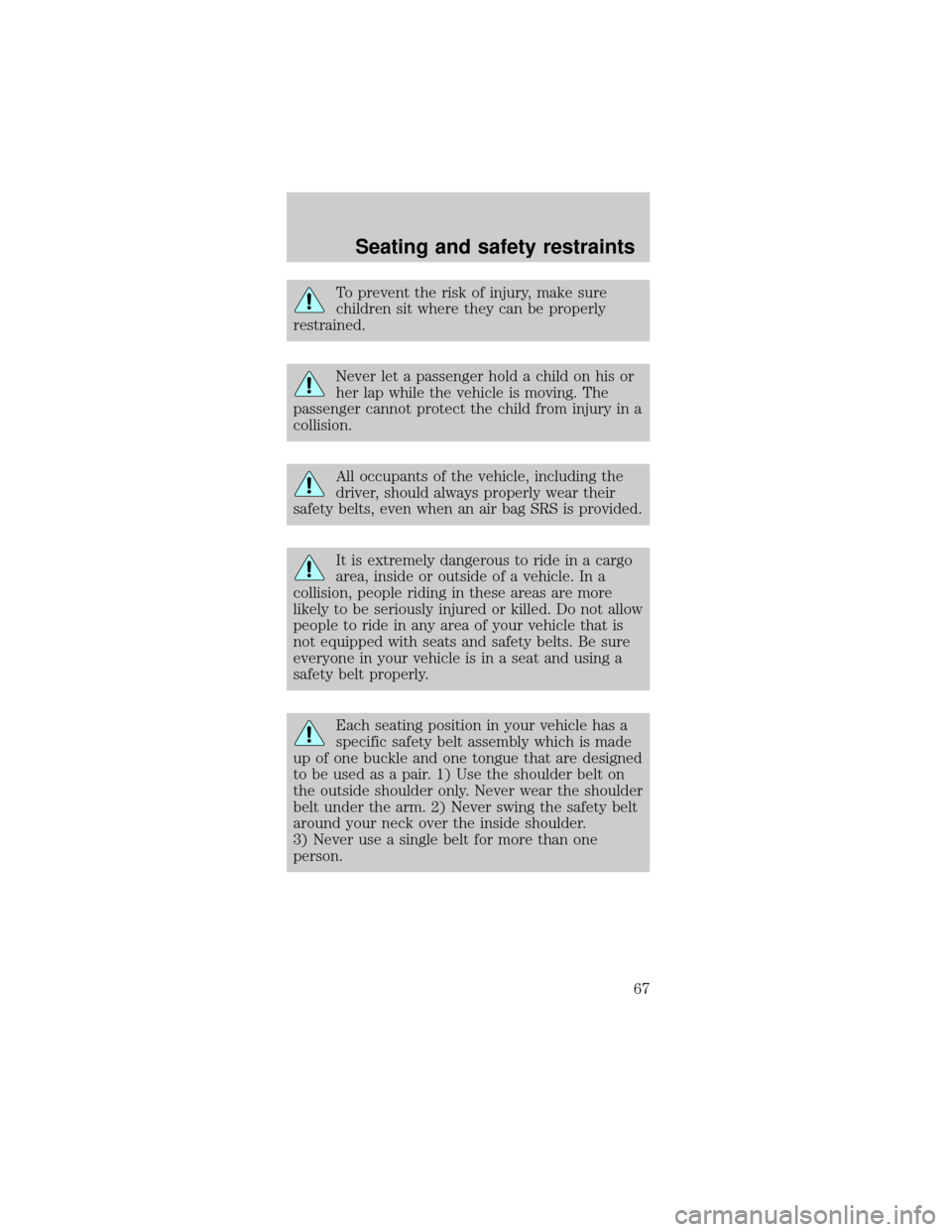
To prevent the risk of injury, make sure
children sit where they can be properly
restrained.
Never let a passenger hold a child on his or
her lap while the vehicle is moving. The
passenger cannot protect the child from injury in a
collision.
All occupants of the vehicle, including the
driver, should always properly wear their
safety belts, even when an air bag SRS is provided.
It is extremely dangerous to ride in a cargo
area, inside or outside of a vehicle. In a
collision, people riding in these areas are more
likely to be seriously injured or killed. Do not allow
people to ride in any area of your vehicle that is
not equipped with seats and safety belts. Be sure
everyone in your vehicle is in a seat and using a
safety belt properly.
Each seating position in your vehicle has a
specific safety belt assembly which is made
up of one buckle and one tongue that are designed
to be used as a pair. 1) Use the shoulder belt on
the outside shoulder only. Never wear the shoulder
belt under the arm. 2) Never swing the safety belt
around your neck over the inside shoulder.
3) Never use a single belt for more than one
person.
Seating and safety restraints
67
Page 68 of 192
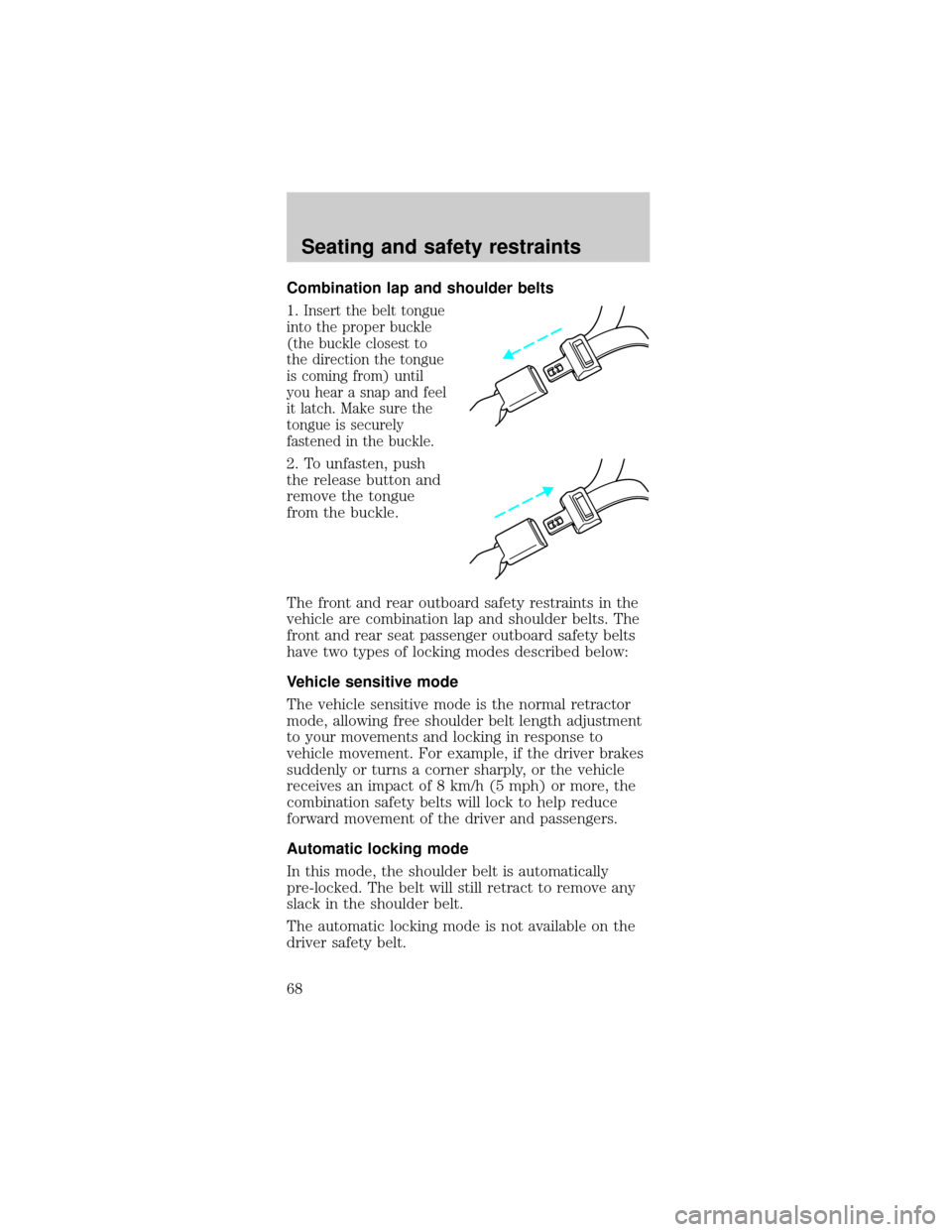
Combination lap and shoulder belts
1.
Insert the belt tongue
into the proper buckle
(the buckle closest to
the direction the tongue
is coming from) until
you hear a snap and feel
it latch. Make sure the
tongue is securely
fastened in the buckle.
2. To unfasten, push
the release button and
remove the tongue
from the buckle.
The front and rear outboard safety restraints in the
vehicle are combination lap and shoulder belts. The
front and rear seat passenger outboard safety belts
have two types of locking modes described below:
Vehicle sensitive mode
The vehicle sensitive mode is the normal retractor
mode, allowing free shoulder belt length adjustment
to your movements and locking in response to
vehicle movement. For example, if the driver brakes
suddenly or turns a corner sharply, or the vehicle
receives an impact of 8 km/h (5 mph) or more, the
combination safety belts will lock to help reduce
forward movement of the driver and passengers.
Automatic locking mode
In this mode, the shoulder belt is automatically
pre-locked. The belt will still retract to remove any
slack in the shoulder belt.
The automatic locking mode is not available on the
driver safety belt.
Seating and safety restraints
68
Page 69 of 192
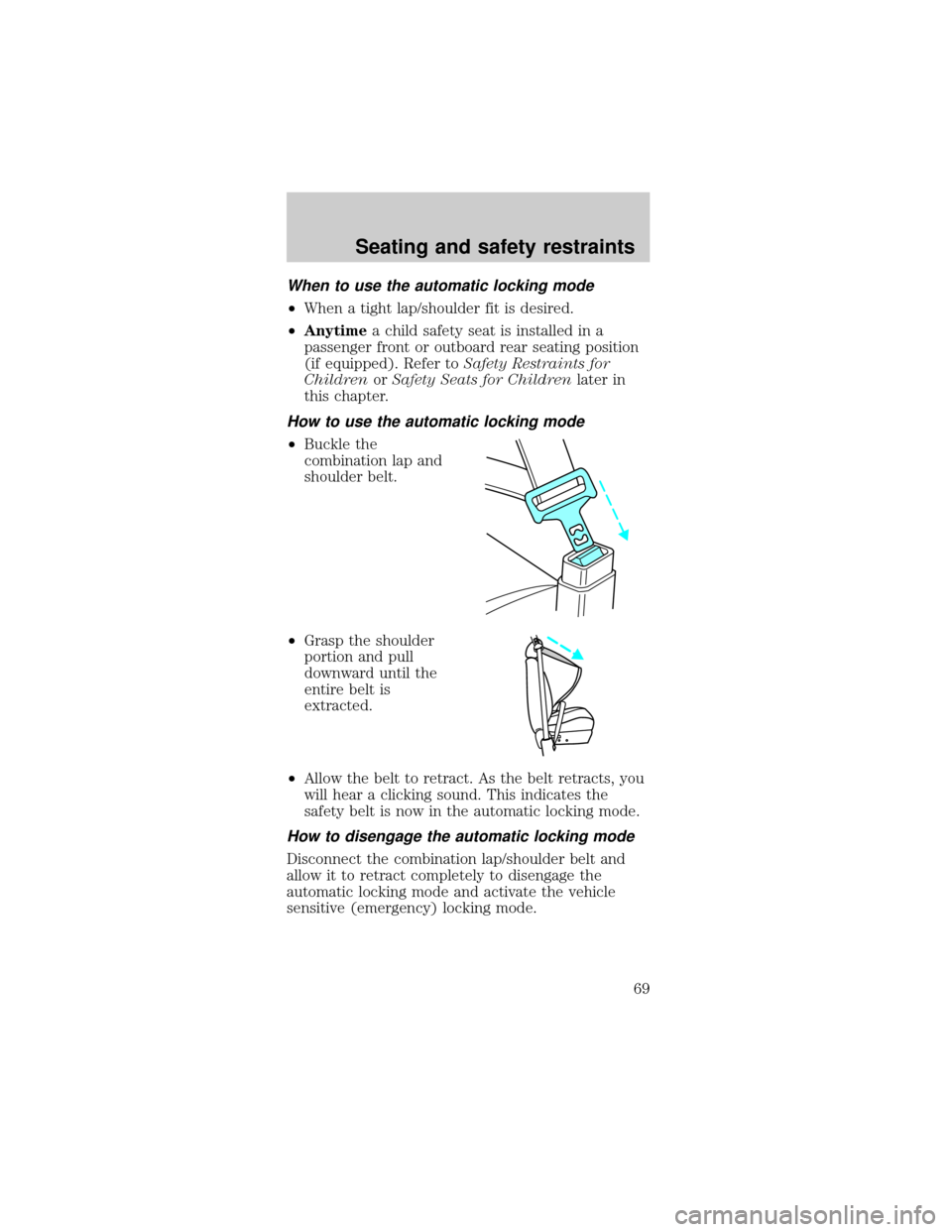
When to use the automatic locking mode
²When a tight lap/shoulder fit is desired.
²Anytimea child safety seat is installed in a
passenger front or outboard rear seating position
(if equipped). Refer toSafety Restraints for
ChildrenorSafety Seats for Childrenlater in
this chapter.
How to use the automatic locking mode
²Buckle the
combination lap and
shoulder belt.
²Grasp the shoulder
portion and pull
downward until the
entire belt is
extracted.
²Allow the belt to retract. As the belt retracts, you
will hear a clicking sound. This indicates the
safety belt is now in the automatic locking mode.
How to disengage the automatic locking mode
Disconnect the combination lap/shoulder belt and
allow it to retract completely to disengage the
automatic locking mode and activate the vehicle
sensitive (emergency) locking mode.
Seating and safety restraints
69
Page 70 of 192
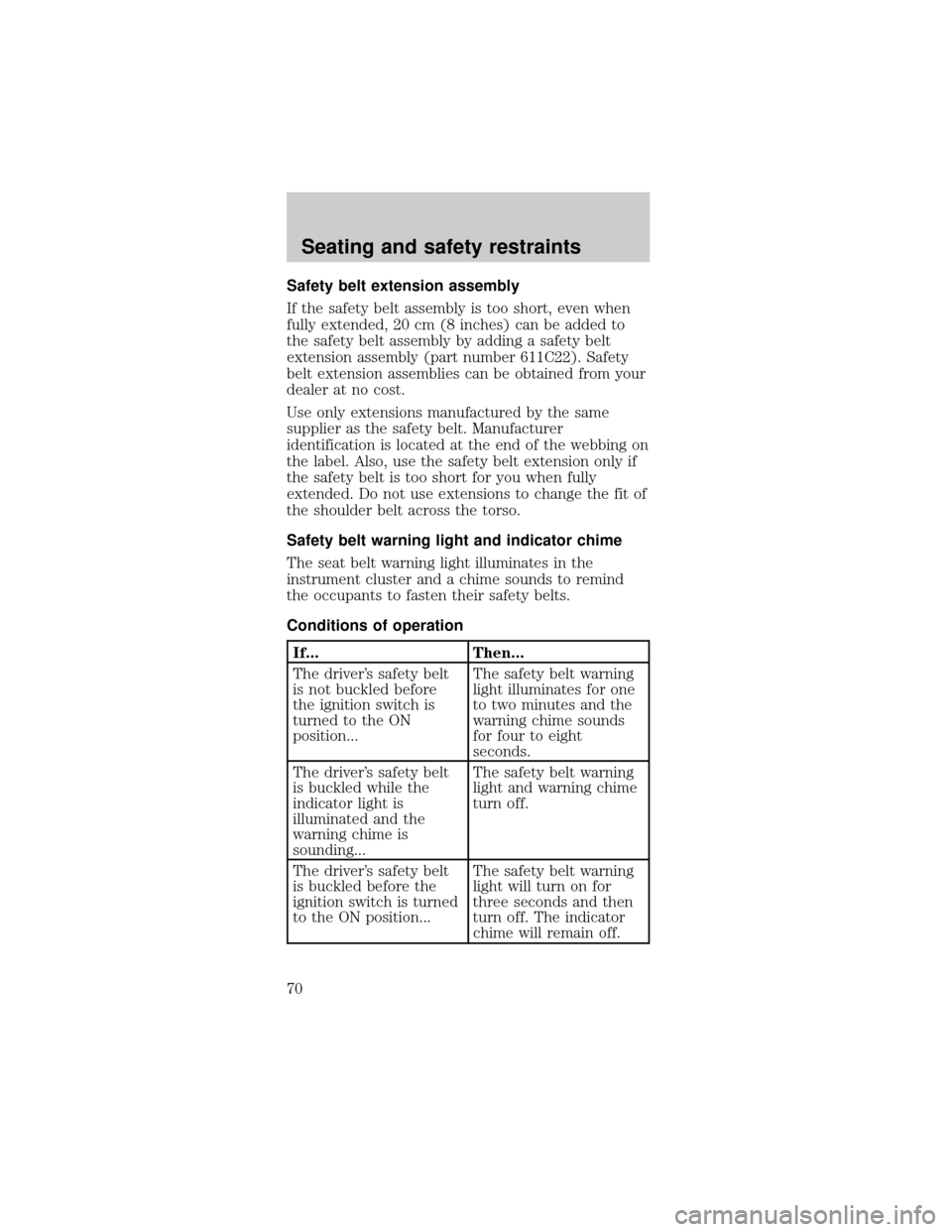
Safety belt extension assembly
If the safety belt assembly is too short, even when
fully extended, 20 cm (8 inches) can be added to
the safety belt assembly by adding a safety belt
extension assembly (part number 611C22). Safety
belt extension assemblies can be obtained from your
dealer at no cost.
Use only extensions manufactured by the same
supplier as the safety belt. Manufacturer
identification is located at the end of the webbing on
the label. Also, use the safety belt extension only if
the safety belt is too short for you when fully
extended. Do not use extensions to change the fit of
the shoulder belt across the torso.
Safety belt warning light and indicator chime
The seat belt warning light illuminates in the
instrument cluster and a chime sounds to remind
the occupants to fasten their safety belts.
Conditions of operation
If... Then...
The driver's safety belt
is not buckled before
the ignition switch is
turned to the ON
position...The safety belt warning
light illuminates for one
to two minutes and the
warning chime sounds
for four to eight
seconds.
The driver's safety belt
is buckled while the
indicator light is
illuminated and the
warning chime is
sounding...The safety belt warning
light and warning chime
turn off.
The driver's safety belt
is buckled before the
ignition switch is turned
to the ON position...The safety belt warning
light will turn on for
three seconds and then
turn off. The indicator
chime will remain off.
Seating and safety restraints
70